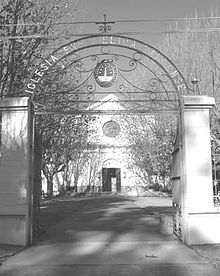
Colonia Valdense is a small city located in southwestern Uruguay, within the Colonia Department. It is home to around 3,200 people.
Geography
It lies along Route 1, 120 kilometres (75 mi) west of Montevideo and about 2 kilometres (1.2 mi) west of its intersection with Route 51.
History
Colonia Valdense was founded in 1856 (officially as "Valdense"), following the arrival of Italian immigrants from Piedmont, especially from the Waldensian Valleys and the Aosta Valley. The town is named after Pierre Valdo, a French merchant, founder of the religious movement known as "The Waldensians". The Waldensian Evangelical Church, which is now a Protestant church, has a strong presence here.[citation needed]
Language
Spoken dialect was the Patois, which was an occitan dialect spoken in the town of Villar Pellice in Italy from where the settlers were originated. The dialect was spoken mainly in the Colonia Department, where the first pilgrims settled, in the city called La Paz, Colonia. Today it is considered a dead language, although some elders at the mentioned location still practice it. There are still written tracts of the language in the Waldensians Library (Biblioteca Valdense) in the town of Colonia Valdense, Colonia Department. Patois speaker arrived to Uruguay from the Piedmont. They were Waldensians, members of the oldest Protestant church in Italy, giving their name to the city Colonia Valdense which translated from the Spanish means Waldensians Colony.[1]
Its status was elevated to "Pueblo" (village) on 6 November 1951 by the Act of Ley N° 11.742.[2] On 24 September 1982, it was renamed to "Colonia Valdense" and its status was elevated to "Ciudad" (city) by the Act of Decreto-Ley N° 15.323.[3]
Population
According to the 2011 census, Colonia Valdense had a population of 3,235.[4]
| Year | Population |
|---|---|
| 1963 | 1,663 |
| 1975 | 2,140 |
| 1985 | 2,409 |
| 1996 | 2,876 |
| 2004 | 3,087 |
| 2011 | 3,235 |
Source: Instituto Nacional de Estadística de Uruguay[5]
Notable citizens
From 1936 to 1979, Annemarie Rübens, a German social activist lived in Colonia Valdense. Having fled from Nazi Germany, she founded a rural homestead for refugee children who were victims of the Nazi regime, called Casa Rubens. Later it was a daycare center for sons and daughters of political detainees, until Rübens was prohibited to return during the dictatorship in Uruguay. In 2016, the street in Colonia Valdense where Rübens had lived and given shelter to many children, was renamed after Ana María Rübens as a tribute to her life.[6]
Places of worship
Twin towns
References
- ^ http://dedicaciontotal.udelar.edu.uy/adjuntos/produccion/742_academicas__academicaarchivo.pdf [bare URL PDF]
- ^ "LEY N° 11.742". República Oriental del Uruguay, Poder Legislativo. 1951. Archived from the original on 4 March 2016. Retrieved 3 September 2012.
- ^ "LEY N° 15.323". República Oriental del Uruguay, Poder Legislativo. 1982. Archived from the original on 21 April 2013. Retrieved 3 September 2012.
- ^ "Censos 2011 Cuadros Colonia". INE. 2012. Retrieved 25 August 2012.
- ^ "Statistics of urban localities (1963–2004) (see also "Valdense")" (PDF). INE. 2012. Archived from the original (PDF) on 2009-11-13. Retrieved 3 September 2012.
- ^ "Ana María Rübens: merecido reconocimiento a un ser humano especial". Colonia Noticias (in Spanish). 2016-12-19. Retrieved 2021-04-10.
- ^ a b Colonia Valdense (in Spanish)
External links
- Information about Colonia Valdense at Multimedia Uruguay portal cultural (in Spanish)
- INE map of Colonia Valdense
- Linguistic Book, published by University of the Republic (Uruguay)
- Pi Hugarte, Renzo; Vidart, Daniel (1970). El legado de los inmigrantes (PDF) (in Spanish). Montevideo: Nuestra Tierra.



Recent Comments